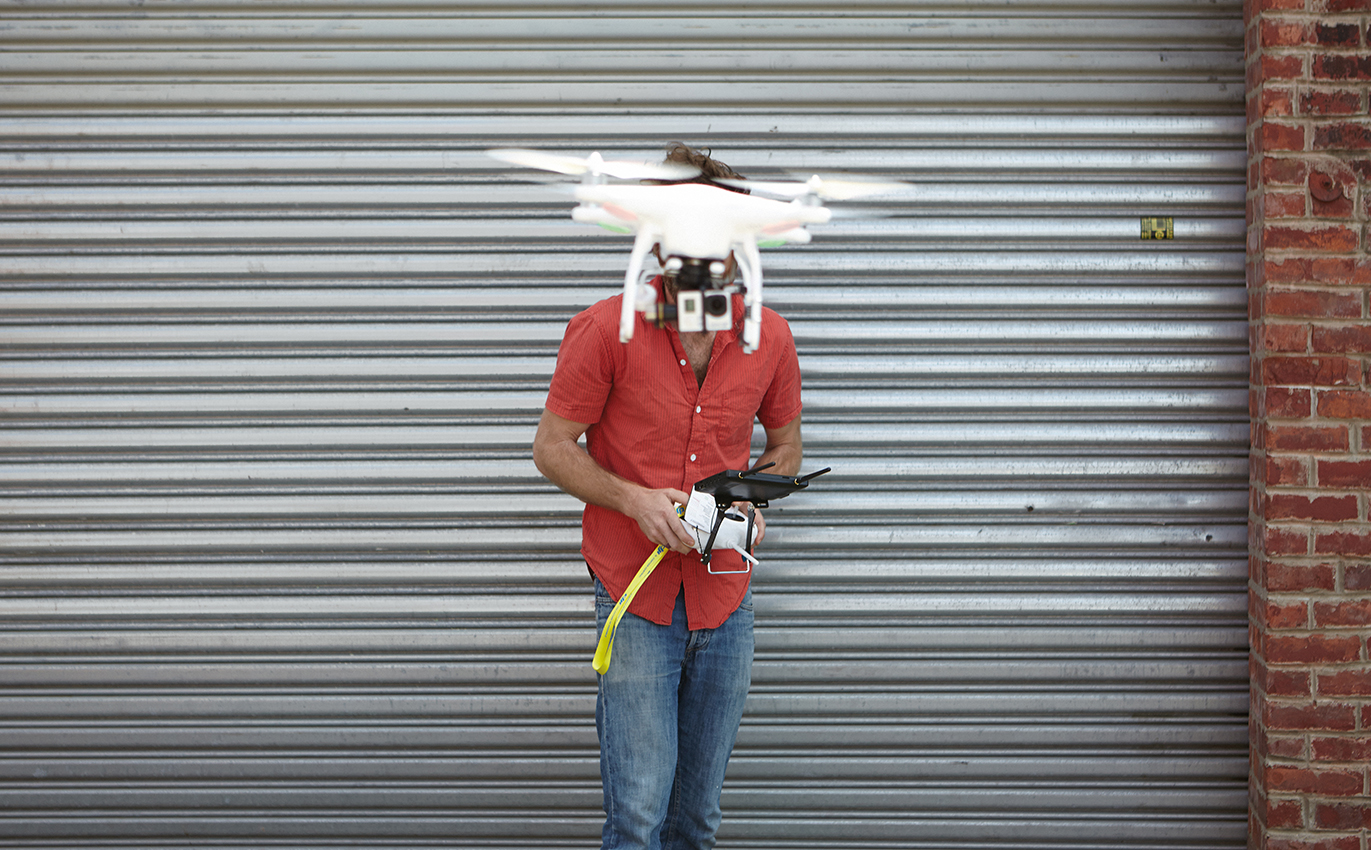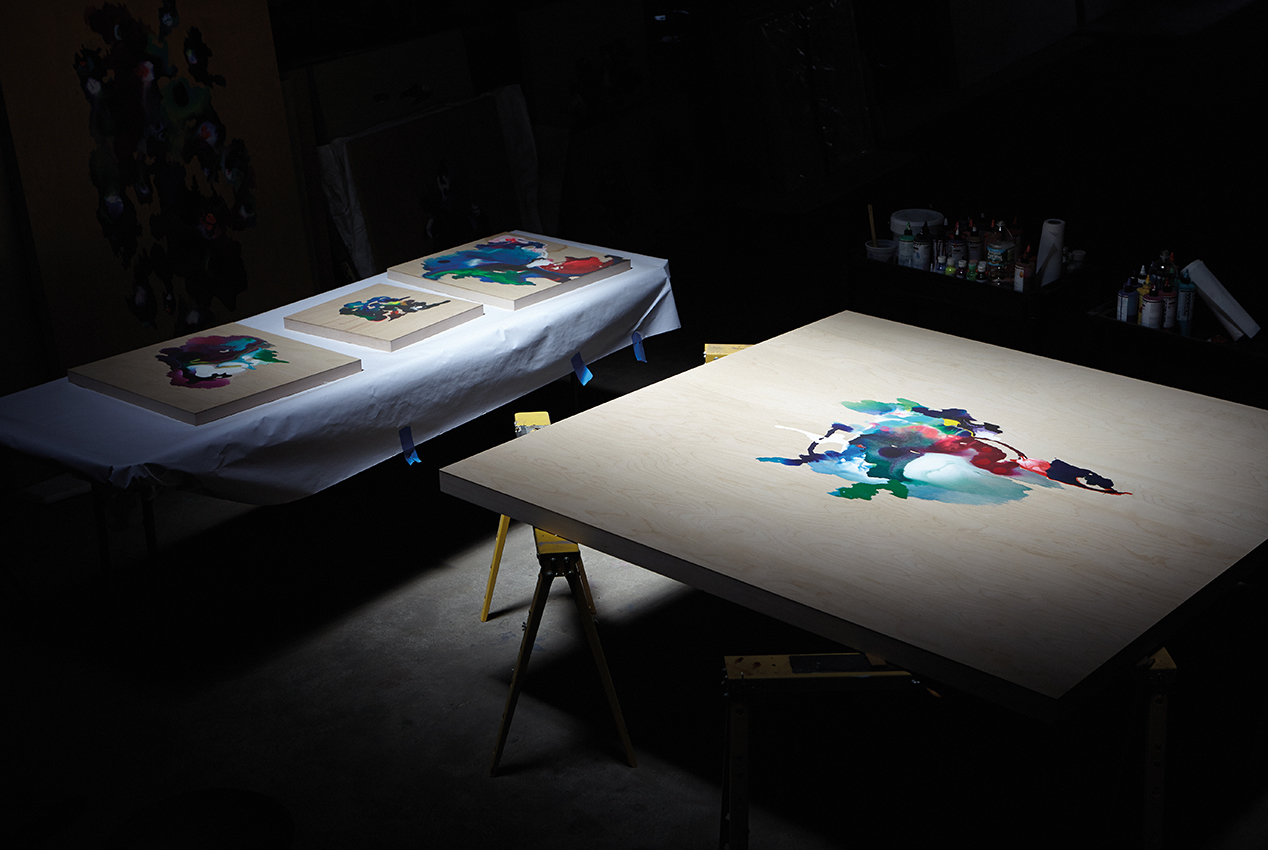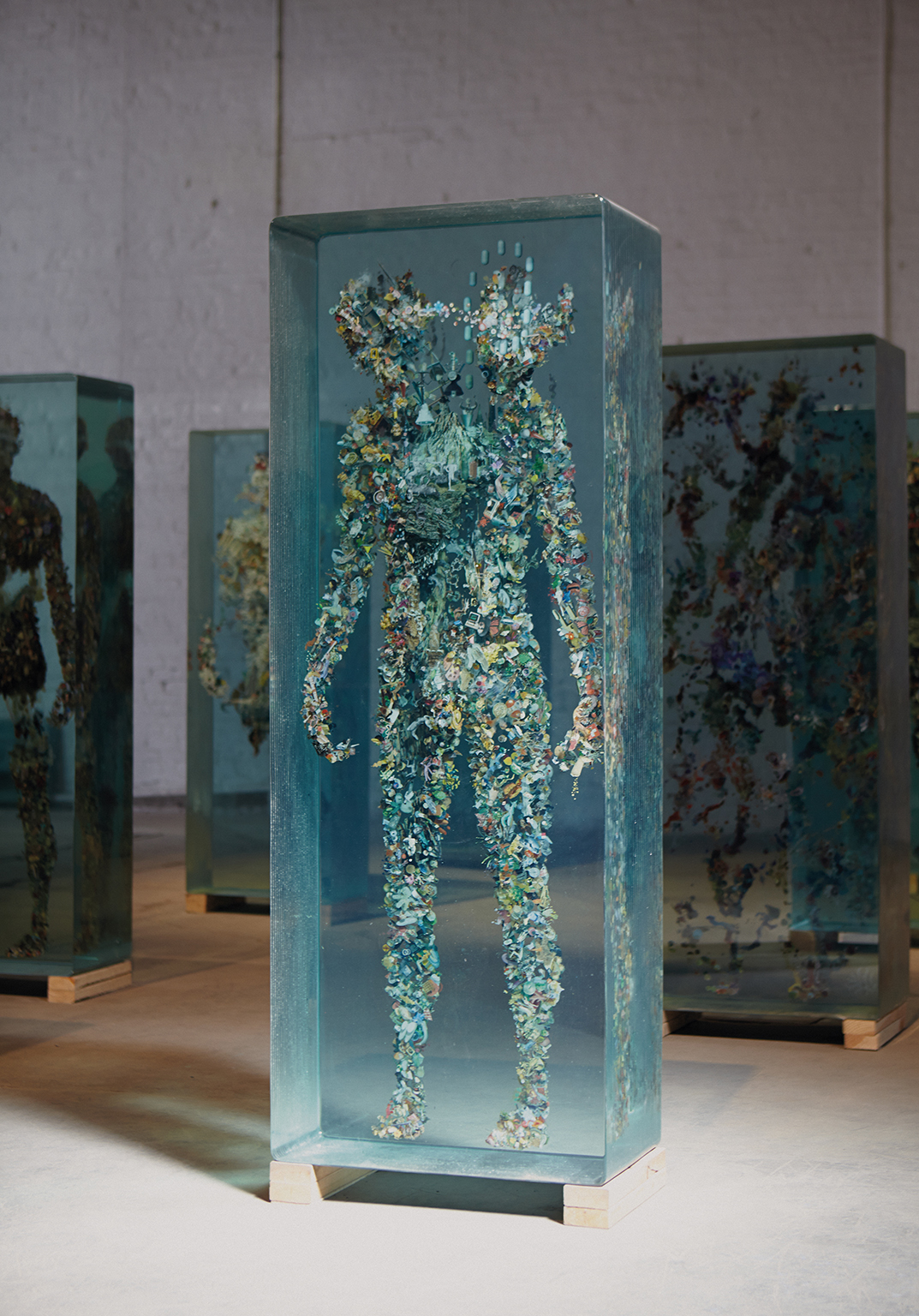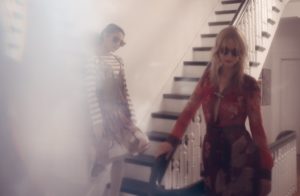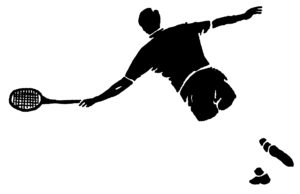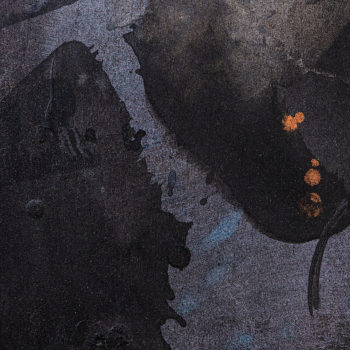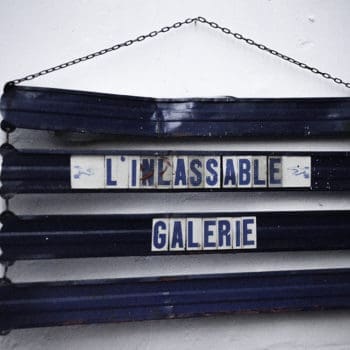by Joice Varvatos
photography Alessandro Simonetti
It’s been nearly twenty years between studio visits with Dustin Yellin and the experiences couldn’t be more different. While the details of that first one may be slightly fuzzy, they were memorable enough to leave an imprint. Back then I worked at Art in America selling ad space to support my more passionate gig representing young artists and curating shows at galleries or friends’ apartments, guerrilla-style. So when I met Dustin at one of my shows he asked me to come see his work. That day, and every day I saw Dustin before and after the visit, he wore the same floor-skimming embellished coat—le petit prince-style, with his nails painted a gothic black or navy. Walking around his SoHo loft, I recall him confidently declaring that he was the greatest painter in the world. The combination of Dustin’s look and arrogance were difficult to digest, and when I saw the decent but not entirely memorable work I thought for sure Dustin would disappear with many of the other struggling young artists of the time. I was wrong.
About fifteen years later I fell in love with a series of resin and ink sculptures sitting on an art dealer friend’s windowsill and dining table. Their beauty was compelling and, until the process was explained, completely mysterious. These sculptural drawings used multiple layers of resin cubes, each covered in delicate ink drawings creating an intricate three-dimensional object. There was a simple tree, a skeleton and an astronaut all floating in the resin cube. Without knowing a thing about the artist I put them all on hold. Then I learned they were by Dustin Yellin. It didn’t compute. How was it possible that the young caped kid I knew created these gems?
So when I was asked to write about Dustin for Grey, I didn’t hesitate. I drove out to his studio expecting great things and once again I was completely taken by the scope of Dustin’s work. It was no longer confined to his brilliant art, but had expanded to the astounding Pioneer Works, a non-profit that Dustin founded from a vision and deep passion to help others create and learn. The 46,000 square foot cultural indoor/outdoor mecca is a home for educational programming, exhibitions, publications, residencies, lectures and performances, all overseen by Dustin and funded by his art sales and generous donations from art lovers.
The time Dustin and I spent together was less an interview and more a catch-up between old friends. But remembering why I was there, I made sure to ask why he switched from paint and canvas to ink and resin, because to me that was the pivotal moment in his career. It was accidental, as the origin of so many genius ideas tend to be. He was messing around, applying resin to his paintings, and he parlayed that into the many layers that make up his current works. At first he used only ink to create the images but soon moved to more detailed imagery by adding collage. Then came the switch from resin to glass because the resin was toxic. That change gave Dustin more flexibility during the process and enabled the works to become that much more detailed.
Massive, multi-colored and multi-dimensional, they are truly monumental. The subjects vary but all seem to veer towards the dark side with elements of humor. The comments from the steady stream of people coming through the studio to admire the works made me smile and I found myself counting the amount of times I heard the words Incredible, Amazing, Wow, How?, and Oh My God!
interview CLAUDIA VITARELLI and KATYA VALEVICH
The plot of land between Pioneer and King Streets, on the Red Hook waterfront, just inland from the Brooklyn Cruise Terminal, occupies a few acres: Pioneer Works, with a garden, is on the water side; more inland is the hyperactive Dustin Yellin Studio. In his studio, which relocated from across the street on Imlay, the boss is a “walking membrane.” Yellin is a mixed-media specialist, artist, and founder of the nonprofit Pioneer Works Center for Arts and Innovation, aimed at nothing short of an interdisciplinary renaissance. Like a film director on set for the rest of his life, he sees no end to the production schedule (he’s mum on “top secret” projects coming, except a book deal with Rizzoli).
In his personal projects, Yellin works predominantly with paint, paper, glass, and people. People in large numbers—at the studio or colliding over a full calendar of special programming at Pioneer Works.
What’s your average day like?
I make sure I’m flying and talking and feeling and thinking.
How many assistants do you have?
I don’t know. I think twelve, or something. Fifteen maybe? There’s a few people that have been with me for many, many years, then others come and go . . . I’m not supposed to smoke in here actually. For my life insurance. My business manager is always telling me not to smoke.
There’s an office space in the corner of this large garage/studio, where a couple of your assistants are working. Is that where your process begins?
No, they’re actually working on an art book I’m making with Rizzoli. That is the cutting room, so everything in there gets cut, and there’s a library for cut-outs.
The cut-outs are then glued on layers of glass, sandwiched together. Do you also store the cut-out images in a database?
We’re trying to scan more things, so we can make 3D composites and animations.
Do you go by theme for cutting images out?
There’s just so much and I can’t get enough. I love art history books, books on sculpture, books on jewelry, books on mechanical devices, books and books, and books and books.
But you archive cut-outs, arranging them in categories.
Yes.
Though you cherish books, you are able to detach from the object. I myself buy books constantly, but have some sort of a reverential approach to the object. I can’t bring myself to cut out of it, write on it, sometimes not even underline.
I’m like that with my books too, but here is where everything gets cut.
Where do you source books?
Sometimes I walk down the street and find a box, sometimes I go to rare books stores. Sometimes I just go to a book store. I find them everywhere.
It’s a process of accumulation.
Everything’s accumulation. We are just accumulations of dust that are somehow conscious. We’re just space dust that became conscious of this existence.
I saw Andrei Tarkovsky’s movie Stalker yesterday, and it reminded me of your work. Especially the water shot, the fragmentation of time. Is that one of your themes?
I don’t like to think of myself as being thematic. I respond viscerally and visually. I don’t think it’s thematic. Unless you think death is a theme, and life is a theme.
Can you tell me about dystopia?
I don’t even think of myself as being dystopic. I think about utopias, or maybe about the harmonic balance between what would be a utopia and what would be a dystopia.
What is the value of utopia?
I don’t know, what is its value?
Does it have a value?
I hope so. Maybe that’s just a state of mind.
What’s your state of mind?
[Laughs] It vacillates rapidly. Today I just want to lay in the grass, in a state of peace, and I want to talk to the turtles.
Let’s look at the human sculptures, Psychogeographies. Do you select the semantic of the images to use in a sculpture beforehand?
No, it’s collectively a result of the people I’m working with, and the materials I’m working with—and it’s just a result of doing things over and over again for so much time. You start to nuance the way you want to float a certain head, or a cave that forms in an interior space.
The final pieces work together as an organism.
Yes, the general vibrations of frequency that each work is gonna be operating on is decided prior. It’s just kind of me, looking at the whole group of one hundred as a single piece, and thinking, “OK, right now the next one going in this group will be like this . . .” It’s a holistic endeavor. [Motions toward Psychogeographies] For this group, I was thinking about the history of the collective unconscious of the individual . . .
It’s an exploded mind of very random parts of a collective unconscious.
Yeah. I try to stay away from anything autobiographical or topical. I intentionally stay away from it.
Brings me back to Carl Jung—the conscious, unconscious, the shadow, the cloud . . . is this your cloud?
I am a cloud. I am a little cloud. But again, this work is one piece. Forget that detail or that gesture. Don’t think of any lines. The space that you’re walking in is more the work than the actual work that you’re looking at is. So think about it that way. The space in which you’re walking in is more the work than the work is.
If the works are so interconnected, how is the experience of parting yourself with your pieces?
I have had women die in my arms and babies born in my lap at this point. I’m just on that fucking boat . . . and I don’t try to think about that.
How long does it take you to finish one of those sculptures?
They’re all different, sometimes weeks, sometimes months. Obviously since it’s all one work, this is taking about five years.
Do you see an end to this?
Fucking yeah! I hope so. About two years.
Did you set your mind to a time frame?
No, I get something in my head. The same way that I’m getting in my head that I want to go somewhere this summer, but I haven’t got a plane ticket yet.
What’s the best trip you’ve had?
That’s an un-answerable question. I think it’s all one trip, and time doesn’t exist.
How do you relate to the shape of time?
It’s like expanding outwards and in all directions simultaneously. If you’re thinking about literal time, I’m always thinking about a five-hundred-year time scale. I’m not making this work for the person that’s gonna come in this week and bring it home, and love it. I’m thinking in, like, four hundred years, how is this gonna tell a story.
You’re never really done with a work. If there is no end, is there a beginning?
There’s no beginning and there are no ends.



